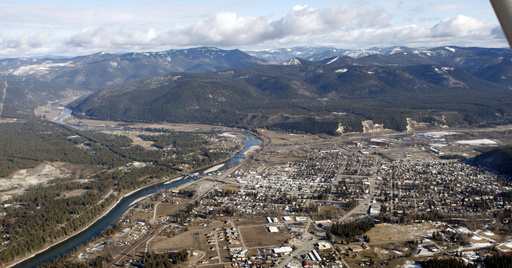HELENA, Mont. (AP) — A federal jury on Monday said BNSF Railway contributed to the deaths of two people who were exposed to asbestos decades ago when tainted mining material was shipped through a Montana town where thousands have been sickened.
The jury awarded $4 million each in compensatory damages to the estates of the two plaintiffs, who died in 2020. Jurors said asbestos-contaminated vermiculite that spilled in the rail yard in the town of Libby, Montana was a substantial factor in the plaintiffs’ illnesses and deaths.
Family members of the two victims hugged their attorneys after the verdict was announced. An attorney for the plaintiffs said the ruling brought some accountability, but one family member told The Associated Press that no amount of money would replace her lost sister.
“I’d rather have her than all the money in the world,” Judith Hemphill said of her sister, Joyce Walder.
The vermiculite from Libby has high concentrations of naturally-occurring asbestos and was used in insulation and for other commercial purposes in homes and businesses across the U.S.
After being mined from a mountaintop outside town, it was loaded onto rail cars that sometimes spilled the material in the Libby rail yard. Residents have described piles of vermiculite being stored in the yard and dust from the facility blowing through downtown Libby.
The jury did not find that BNSF acted intentionally or with indifference so no punitive damages were awarded. Warren Buffett’s Berkshire Hathaway Inc. acquired BNSF in 2010, two decades after the W.R. Grace & Co. vermiculite mine near Libby shut down and stopped shipping the contaminated mineral.
The estates of the two victims argued that the railroad knew the asbestos-tainted vermiculite was dangerous and failed to clean it up. Both lived near the rail yard decades ago and died from mesothelioma, a rare lung cancer linked to asbestos exposure.
The pollution in Libby has been cleaned up, largely at public expense. W.R. Grace, which played a central role in the town’s tragedy, filed for bankruptcy in 2001 and paid $1.8 billion into an asbestos trust fund to settle future cases.
Yet the long timeframe over which asbestos-related diseases develop means people previously exposed are likely to continue getting sick for years to come, health officials say.
The case in federal civil court over the two deaths was the first of numerous lawsuits against the Texas-based railroad corporation to reach trial over its past operations in Libby. Current and former residents of the small town near the U.S.-Canada border want BNSF held accountable, accusing it of playing a role in asbestos exposure that health officials say has killed several hundred people and sickened thousands.
“This is good news. This is the first community exposure case that will hold the railroad accountable for what they’ve done,” said Mark Lanier, an attorney for Walder and Hemphill’s estates.
The railroad was considering whether to appeal, said a BNSF spokesperson, who referred to it as a “very sad case.”
“They (the jury) had the difficult task of evaluating conduct that occurred more than 50 years ago, before BNSF ever existed,” said Kendall Sloan, the railroad’s director of external communications.
BNSF attorney Chad Knight told jurors last week the railroad’s employees didn’t know the vermiculite was filled with hazardous microscopic asbestos fibers.
“In the ‘50s, ’60s and ’70s no one in the public suspected there might be health concerns,” Knight said Friday.
The railroad’s experts also suggested during the trial that the plaintiffs could have been exposed to asbestos elsewhere.
The railroad said it was obliged under law to ship the vermiculite, which was used in insulation and for other commercial purposes, and that W.R. Grace employees had concealed the health hazards from the railroad.
U.S. District Judge Brian Morris had instructed the jury it could only find the railroad negligent based on its actions in the Libby Railyard, not for hauling the vermiculite.
Former Libby resident Bill Johnston, who followed the trial, said he was glad the victims’ estates got a substantial award.
Johnston, 67, recalled playing in piles of vermiculite at the rail yard as a child and helping his father add piles of the material to their home garden, where it was used as a soil amendment. He, his two siblings and their parents have all been diagnosed with asbestos-related diseases, Johnston said Monday.
“They didn’t do anything intentionally to cause this harm to their body. Other people knew about it and didn’t care,” he said of Libby asbestos victims. “What’s that worth? It’s hard to put a value on that. But when you say you’re going to die prematurely or the life you have left is going to be tethered to an oxygen bottle, there should be some value that makes their life easier in the end.”
BNSF was formed in 1995 from the merger of Burlington Northern railroad, which operated in Libby for decades, and the Santa Fe Pacific Corporation.
Looming over the proceedings was W.R. Grace, which operated the mountaintop vermiculite mine 7 miles (11 kilometers) outside of Libby until it closed in 1990. Morris referred to the chemical company as “the elephant in the room” during the BNSF trial and reminded jurors repeatedly that the case was about the railroad’s conduct, not W.R. Grace’s separate liability.
Federal prosecutors in 2005 indicted W. R. Grace and executives from the company on criminal charges over the contamination in Libby. A jury acquitted them following a 2009 trial.
The Environmental Protection Agency descended on Libby after 1999 news reports of illnesses and deaths among mine workers and their families. In 2009 the agency declared in Libby the nation’s first ever public health emergency under the federal Superfund cleanup program.
A second trial against the railroad over the death of a Libby resident is scheduled for May in federal court in Missoula.



